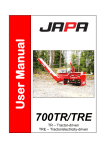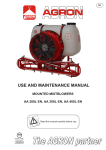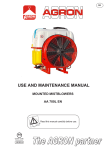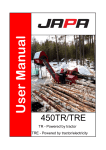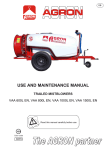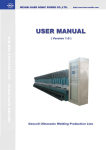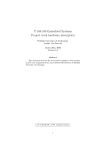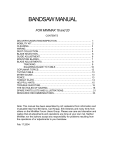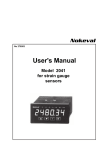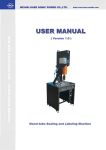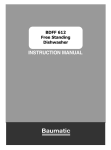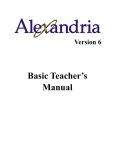Download 100 Manual - Apache Forest Products Inc.
Transcript
TR E OPERATING INSTRUCTIONS ENGLISH TABLE OF CONTENTS 1. Declaration of Conformity ........................................................................................................................................ 2 2. Foreword .................................................................................................................................................................... 4 2.1 Intended use of the machine.................................................................................................................................... 4 2.2 Guidance and warning signs in the machine ......................................................................................................... 5 2.3 Nameplates of the machine...................................................................................................................................... 7 2.4 Machine models ........................................................................................................................................................ 7 2.5 Sound level and vibration ........................................................................................................................................ 7 2.6 Safety instructions .................................................................................................................................................... 8 2.7 Terms of warranty ..................................................................................................................................................... 9 3. Putting the machine into operation ....................................................................................................................... 11 3.1 Delivery inspection of the machine ....................................................................................................................... 11 3.2 Lifting points (2) ..................................................................................................................................................... 11 3.3 Main parts of the machine (3.4) ............................................................................................................................. 11 3.4 Driving power of the TR-models (4) ...................................................................................................................... 13 3.5 Driving power of the E-models (5) ......................................................................................................................... 13 4. Using the firewood processor ............................................................................................................................... 14 4.1 Measures before use .............................................................................................................................................. 14 4.2 Emergency stop (6) ................................................................................................................................................. 15 4.3 Cutting (8.9) ............................................................................................................................................................. 15 4.4 Splitting (10,11) only the S models........................................................................................................................ 15 4.5 Efficient use ............................................................................................................................................................. 16 4.6 Cleaning ................................................................................................................................................................... 17 5. Maintenance ............................................................................................................................................................ 18 5.1 Maintenance measures (12) ................................................................................................................................... 18 5.2 Emergency stop (13) ............................................................................................................................................... 18 5.3 V-belts (13) ............................................................................................................................................................... 19 5.4 Angular gear (13)..................................................................................................................................................... 19 5.5 Electric motor .......................................................................................................................................................... 19 5.6 Cross-cut blade (14) ................................................................................................................................................ 20 5.7 Blade shaft ............................................................................................................................................................... 21 5.8 Splitting tip (15); only in the S models .................................................................................................................. 21 5.9 Annual maintenance ............................................................................................................................................... 22 6. Maintenance schedule ............................................................................................................................................ 23 7. Fault finding ............................................................................................................................................................. 23 7.1 Electric equipment (16) ........................................................................................................................................... 25 8. Technical data ......................................................................................................................................................... 26 9. Spare parts .............................................................................................................................................................. 27 Translation 1 IM-100_v.3-2011 1. Declaration of Conformity The Machine meets the requirements of the Directive 2006/42/EY being put into effect through the Government decree no. 400/200 Manufacturer: Laitilan Rautarakenne Oy Kusnintie 44 FI-23800 Laitila, Finland Tel. +358 2857 1200 Fax. +358 2857 1201 Web: www.japa.fi The person in charge of the Technical Construction File is Jami Paavola The declaration is valid for the following models: JAPA 100 TR JAPA 100 E JAPA 100 S TR JAPA 100 S E Powered by: Tractor PTO or electric motor (4 kW/400V). The following standards have been applied in manufacturing the machine: SFS-Handbook 93-series, SFS-EN 349-1+A1, SFS-EN 609-2, SFS-EN 8471+A1, SFS-EN 847-2+A1, SFS-EN 847-3, SFS-EN 953+A1, SFS-EN 954-1, SFS-EN 1870-6+A1, SFS-EN 4254-1, SFS-EN 11684, SFS-EN 12100-1+A1, SFS-EN 12100-2, SFS-EN 13850, SFS-EN 13857, SFS-EN 14121-1, ISO/TR 14121-2, SFS-EN 60204-1+A1. Notified body: nr. 0504 MTT Mittaus ja standardisointi (Vakola) Vakolantie 55 FI-03400 Vihti Laitilan Rautarakenne Oy 31.01.2011 Henri Nurminen Managing Director Translation 2 IM-100_v.3-2011 WE CONGRATULATE YOU FOR THE PURCHASE OF YOUR NEW JAPA FIREWOOD PROCESSOR! FILL IN THE NAMEPLATE WITH THE MACHINE’S DATA AND WRITE DOWN THE DEALER'S CONTACT INFORMATION: Salesperson: Tel. : Dealer: Address: Read this instruction manual before starting the operation or the service. Translation 3 IM-100_v.3-2011 2. Foreword Laitilan Rautarakenne Oy (JAPA) is a Finnish company with extensive product development. Our goal is to produce simple but reliable and durable machines with a long service life. If you operate your JAPA machine in a due manner and maintain it following the instructions in this manual, your machine will serve you efficiently for a long time. If there is anything that you would like to discuss in greater detail, please contact your dealer or us here directly at the JAPA-factory. This manual is intended for professional users. The operator must have ordinary knowledge and skills. Familiarise yourself thoroughly with these operating instructions before starting the installation work or the operation. Familiarise yourself with the features and safety equipment of the machine after you have read the manual: after that you can start working. Keep this manual with the machine at all times. At the time of printing, all instructions, descriptions and technical specifications were based on the latest data of the machine's construction. The manufacturer, however, is continuously developing and improving the machine and, therefore reserves the right to alter its design and safety features without prior notice. We at JAPA are confident that you will be satisfied with your new firewood processor. The machine complies with all the safety requirements of the European Union and as a sign of this, it bears the CE sign. To ensure rapid and efficient service when ordering spare parts or in the possible event of malfunction, you should give the information on the nameplate of the machine to the sales person or the mechanic. Write down the data in the nameplate in the place reserved for it in order to make it available whenever needed. If you cannot solve the problem on your own, contact the dealer who will settle the matter together with the manufacturer. 2.1 Intended use of the machine The Japa 100 firewood processor is intended for cutting and splitting of firewood of at maximum 3-metre-long logs. Efficient, and above all, carefree, 700-mm hard-metal blade cuts the log up to 25 cm in diameter. The cutting length can be adjusted between 25 and 60 cm. The screw splitter is intended for splitting logs between 5 to 25 cm in diameter and between 25 and 60 cm in length. Use of the machine for any other purpose than processing firewood is prohibited. The residual risks in the machine have been notified in the warning signs and in the safety instructions for the machine. Translation 4 IM-100_v.3-2011 2.2 Guidance and warning signs in the machine Wear both the hearing protectors and eye guards Wear suitable work clothing, gloves and shoes Read the instruction manual before starting the operation or the service Check the condition of the machine before starting the use DECAL-0111 Translation 5 IM-100_v.3-2011 DECAL-0005 Beware of the rotating crosscut blade! Direction of rotation of the blade. The machine must only be operated by one person! Danger zone 10 m. DECAL-0117 User manual for emergency stop DECAL-0030 DECAL-0009 Location of emergency stop DECAL-0028 Direction of rotation Lifting point DECAL-0025 Beware of rotating PTO-shaft! Maximum permissible speed and direction of rotation of the PTO-shaft DECAL-0057 Direction of rotation of splitting screw Beware of rotating splitting cone! Position and minimum diameter of the log to be split. Translation 6 IM-100_v.3-2011 2.3 Nameplates of the machine The nameplate of the machine is located on the tractor's side behind the machine. Blade 1 Serial number of the machine Year and date of manufacture Machine's weight Voltage (TRE) Max. rotational speed of the PTO Max. pressure of the hydraulics Diameter of crosscut blade/blade hole The name and address of the manufacturer CE-sign 2.4 Machine models JAPA 100 E JAPA 100 S E JAPA 100 TR JAPA 100 S TR An electrically driven firewood processor with cross-cut blade An electrically driven firewood processor with cross-cut blade and splitting cone A tractor-driven firewood processor with cross-cut blade A tractor-driven firewood processor with cross-cut blade and splitting cone. 2.5 Sound level and vibration According to the standard EN ISO 3744:2009 is 100.6 dB, the A-weighted sound power level of the JAPA 100 firewood processor, and the avarage sound pressure level is 80.6 dB. The vibration emission values do not exceed the limit 2,5m/s2. Where the machine is powered by a tractor, the sound of the tractor may dominate the work site. Always wear appropriate hearing protection: earmuffs or ear plugs. We recommend using a logger's helmet. Translation 7 IM-100_v.3-2011 2.6 Safety instructions These safety regulations are of a general nature. Also all other relevant health and safety related instructions, traffic regulations concerning transportation and the requirements of the general legislation must be observed while handling the machine. Following the instructions helps prevent accidents in advance. The machine may only be operated by a person who is familiar with use of the machine and its operating instructions. The operator must never be under the influence of alcohol or drugs. Observe the requirements imposed on the operator. The operator of the machine must be at least 18 years old. Familiarise yourself carefully with the safety and installation instructions as well as with the operation and control functions before you install the machine or put it into operation. A. General regulations: The machine is exclusively intended for processing firewood. The firewood processor is intended for operation by one adult person only. Make sure that all other people stay outside the operating range. Danger zone 10 m. Always ensure that the electric conductors, if any, are intact. Do not wear loosely-fitting or hanging clothing. Always wear approved eye guards and hearing protectors! Clean and service the machine regularly. Always stop the machine before servicing and disconnect the PTO-shaft of the tractor-powered machine (TR), or the power cord of the electrically powered machine (E). B. Workplace: Select a sufficiently firm and even workplace. Keep the working space clean and clear of foreign objects. Ensure, that the surface near the machine is not slippery. Never use the machine indoors – dust may get into your airways or causes a fire hazard. Only operate the machine in a sufficiently lit space – preferably in daylight. Bring the machine into the work position and always check its safety-related devices before start-up. C. During working: Exercise particular caution when cutting knotty or crooked trees. As a result of faulty cutting, the log may roll over and cause an injury or a machine failure. Careless cutting or splitting may cause unexpected danger situations. Only use fault-free power take-off drive shafts and attach the chain for the shaftguard to the machine. Avoid unnecessary lifting by using a suitable log-stand. Do not lift logs onto the in-feed conveyor using a grapple lift. Never remove any safety-related devices from the machine. Remember that you are fully responsible for any injuries caused by the removal of any such devices from the machine, or by any modification to its operation! Translation 8 IM-100_v.3-2011 2.7 Terms of warranty Roles Laitilan Rautarakenne Oy, Kusnintie 44, FI-23800 LAITILA Tel.: +358-(0)2-857 1200, Fax: +358-2-857 1201, Email: [email protected]. Dealer The Dealer is an enterprise that is authorised by Laitilan Rautarakenne Oy to sell JAPA products in its area. The Dealer is the customer's contact point in matters related to the warranty for those JAPA products that the Dealer has sold and delivered. Buyer The Buyer is any person or entity that has obtained a JAPA product for its use. The Buyer is obliged to notify the Dealer of any defect that is observed during the warranty period, and to keep the receipt as evidence of the place and time of purchase of his JAPA product. As required, the Buyer is obliged to also submit the data given on the nameplate to the Dealer. Scope and territory of the warranty The warranty only applies to the JAPA product manufactured by Laitilan Rautarakenne Oy. This warranty is valid in Finland, and in every country covered by the export plan of Laitilan Rautarakenne Oy. Validity period of the warranty The warranty lasts for one (1) year from the date of delivery of the JAPA product. The warranty becomes void if the product, including related safety equipment, gets modified, is used for another purpose than that intended, or disabled. Scope of the warranty The Guarantor warrants that the applicability and quality of the JAPA product remain as standard throughout the warranty period. If not, the product is deemed to be defective. Defects are considered to include, for example, any shortcomings in workmanship or construction as well as any other faults or deficiencies observed during the warranty period that impair the usability of the product. The Guarantor, however, will not be responsible for any defect if the discrepancy from the standard level in terms of quality or usability is caused by something for which the Buyer is accountable. Such a cause might be, for example, an accident, or not following the operating and maintenance instructions when using the machine, or using it in any other inappropriate way. The warranty covers neither the liquids required nor the consumables that need to be changed from time to time, such as filters, blades, belts or tyres. The warranty does not cover transport damages or any related consequential expense incurred. What to do in case of a defect The Buyer shall notify the Dealer of the defect within a reasonable time of the defect being first observed. Translation 9 IM-100_v.3-2011 When reporting the defect, the Buyer shall either present the warranty certificate, the purchase receipt or any other reliable evidence of where and when the product was purchased. Such evidence does, however, not have to be presented, if the place and time of purchase can be established from a register kept by the Dealer. The Dealer shall submit the claim to the Guarantor. The Guarantor is responsible either for correcting the fault or for exchanging the product for a fault-free one. The Guarantor shall correct the fault or deliver a fault-free part within a reasonable period of time after the Dealer has reported the fault. The substitute can also be a component repaired under the warranty. Repair under the warranty does not extend the warranty period of the entire product or any individual component. The warranty covers any part that get damaged during normal operation due to defects in material or workmanship. If the component is a part of, for example, the hydraulic system, the electric system or the transmission, the Guarantor requires that the damaged part be returned to the factory before the replacement part will be sent to the dealer without debiting. Reasonable expense of repairing the fault The Guarantor is in the first place entitled to repair the fault, if this can be done within a reasonable period of time considering the nature and scope of the fault, provided that this can be done without causing expense or essential inconvenience to the Buyer. If repairing the fault cannot be carried through within a reasonable period of time, the repair work can be carried out in a workshop recommended by the Dealer and authorised by the Guarantor or by some other means (for example, the Buyer doe the repairs himself). In this case, moderate disbursement may be made for the work carried out, as agreed upon with the Guarantor. In the first place, this reasonable disbursement will be submitted in the form of product delivery. No discount will be granted from the purchase price. The reasonable expense incurred as a result of repairing the fault will be disbursed to the Dealer in accordance with the written agreement between the Dealer and the Guarantor. To be disbursed with this reasonable compensation for the repair work requires that the work be carried out following the manufacturer's instructions, the Guarantor's consent be obtained and the broken component be returned. Resolving any disputes Any disputes between the Guarantor and the Buyer shall in the first place be resolved by mediation of the Dealer. As required, negotiations without the Dealer participating are also possible. If disputes cannot be resolved by negotiation between the parties, the Buyer with consumer status can forward the dispute to the Consumer Complaint Board for handling. If the dispute has to be brought to court, the proceedings shall take place in the district court of the Guarantor’s place of business. Translation 10 IM-100_v.3-2011 3. Putting the machine into operation 3.1 Delivery inspection of the machine Inspect the machine immediately after having taken delivery. If the product shows signs of transport damage or any parts are missing, contact the carrier and the dealer immediately. Perform the check using the following pictures (2.3), presenting the main parts of the machine, as an aid. Please note that the model of the machine in the following picture is Japa 100 S E with splitting screw. The Japa TR models do not have transport wheels (13), but are equipped with hitching points to three-point linkage (2.4). Only the S-models come with a splitter. 3.2 Lifting points (2) 2 The firewood processor may only be lifted by the marked places or the places defined in the instructions. Lifting by any other point using, for example, a forklift may damage the firewood processor. As a rule, transfer the machine only by its hitching points (TR) or on the transport wheels (E). If the machine must be lifted, for example, onto or down from a platform, use the lifting loop presented in the picture (7). 3.3 Main parts of the machine (3.4) 4. Cross-cut saw-blade, diameter 700 mm, hole 35 mm. Capacity up to 25 cm in diameter. 5. Moving blade cover, is locked while the in-feed deck (3.) is in the open-position 6. In-feed deck, is locked in the transport position by means of the lever (8.). 7. Crank for transport wheels, lifting/lowering of the wheels (13.) [in E-models only]. 8. Extension table, steplessly adjustable, length of the log to be cut 1,5 – 3,0 m. 9. Wood length limiter, steplessly adjustable from 20 to 60 cm. 10. Log clamp, recommended in particular for short logs. 11. Latch, for locking the in-feed table (3.) in the transport position 12. Splitting cone, diameter 100 mm, thread M25 Capacity up to 25 cm in diameter. 13. Splitting deck with a fixed blade cover and a safety locking handle. 14. Billet chute, into which the logs fall after cutting. 15. Latch, for locking the in-feed table (10.) in the transport position. 16. Transport wheels, for transporting the unit [in E-models only]. 17. Emergency stop, for stopping the machine at an emergency Translation 11 IM-100_v.3-2011 1 2 3 4 5 6 7 8 3A 3B 3C JAPA 100S Translation 12 IM-100_v.3-2011 3.4 Driving power of the TR-models (4) The Japa 100 TR models are powered by the PTO-shaft of the tractor. The Cardan shaft (option) is connected to the angular gear (4A) of the firewood processor. The unit is equipped with a CAT1 attachment to the three-point linkage (4B); always connect the firewood processor to the tractor. Connect the Cardan shaft, and make sure that it is of correct length. If the shaft is too short, it may cause damage if it breaks. A too long shaft may damage the angular gear during lifting. Fix the protective covers for the shaft so that they cannot rotate under any circumstances. Start the tractor, engage the power take-off and increase the rotational speed of the shaft to 400 r.p.m. Perform the shut off in the reverse order. 4 A B When you turn on the unit, make sure that there is no-one in the danger zone! 3.5 Driving power of the E-models (5) The E-models are equipped with an electric motor 4 kW/400V (5A), which is located inside the body, protected against impurities and shocks. 1. Lift the transport wheels using the crank (2.4). 2. Make sure that the unit is firmly supported on the surface. 3. Connect the electric cord to the machine (3P/16A): only use a socket outlet with fault current switch. 4. Start the firewood processor by pressing the green button Ensure that it rotates in the direction indicated by the arrow. 5. Shut down the unit by pressing the red button. Translation 13 IM-100_v.3-2011 5 A 4. Using the firewood processor 4.1 Measures before use read the user manual, and ensure that the operator of the unit fully understands how the machine works, and is aware of the risks that its use involve. The machine is intended for operation by one person only. Ensure that there are no other people in the working area. Wear appropriate clothing, protective gloves and safety shoes. Wearing loose clothing increases the danger of sticking. Also remember the safety goggles and the hearing protectors. We recommend using a loggers's helmet. Lift the transport wheels into their upper position (E). / Attach the firewood processor to the tractor (TR). Make sure that the machine is standing firmly in position. Check the operation of the protective equipment and the condition of the blades. Release the in-feed deck and the splitting deck from their transport positions before starting the machine. Bear in mind the maximum capacity of the machine. Do not saw logs over 3 m in length or 25 cm in diameter. The firewood processor is intended for operation by one person only CUTTING SPLITTING MAX Ø = 25cm MAX L = 3.0m MAX L = 60 cm MIN L = 25 MAX Ø=25 cm Translation 14 MIN Ø = 5cm IM-100_v.3-2011 4.2 Emergency stop (6) All the Japa 100 firewood processors are equipped with an emergency stop (6A), which stops the unit in less than ten seconds (10 s). The power source (electric motor or the Cardan shaft) does not stop when the emergency stop is used. The operation of the emergency stop must be checked before each time of operation. See point 4.2 for adjustment. 1. Work position, the crank pulled forward (see picture) 2. Emergency stop, the crank pushed into its rear position (in the direction of the arrow). 1 6 2 A After using the emergency stop, switch off the power source before resetting the emergency stop! 4.3 Cutting (8.9) A. Undo the tightening screw and pull out the extension table. B. Release the latch for the extension table. C. Adjust the cutting length of the log. Never adjust the limiter, while the machine is running. D. Press the log firmly against the deck by raising the handle of the clamp with your right hand. Push the table forward with your left hand, in the direction of the arrow. The log will be cut and falls into the chute. Never grasp the wood that you are sawing. 4.4 Splitting (10,11) only the S models A. Release the latch for the splitting deck. B. Place the log firmly onto the deck in an upright position. Keep the log by its end. C. Pull the latch up with your hand, grip the handle firmly, and push it in the direction of the arrow to split the log. You can repeat this procedure even to a billet that has already been split. Only split one billet at a time. Translation 15 IM-100_v.3-2011 The machine must be switched off during set-up and adjustment! Never leave the machine running unattended! Keep your hands and feet out of risk zone at all times! Follow the operating instructions, stay calm, and keep clear of the machine's moving parts! 8 9 D A B C 1 C 11 B A 4.5 Efficient use 1. Cut the log completely, but do not exceed the volume of the billet chute. 2. Split all the billets from the chute and throw them to a suitable distance away. 3. Take a new log and repeat the stages 1. – 2. Translation 16 IM-100_v.3-2011 Sufficiently spacious work area is an important safety feature. A messy environment can cause a serious danger, such as slipping or tripping. Problems During working, such problems may occur that endanger the operator. If the log sticks to the blade during sawing, switch off the machine using the emergency stop to avoid any danger. Switch off the driving power of the machine and release the log from the cross-cut blade. If the log that you intend to split does not come loose of the splitting screw despite the deck being pulled back, switch off the machine using the emergency stop to avoid any danger. Switch off the driving power of the machine and release the log from the splitting screw, for example, with an axe. The unexpected behaviour of icy, knotty or crooked trees may cause malfunctions. Exercise absolute caution, while processing such trees. At restart, always disengage the emergency stop before switching on the driving power! Always switch off the machine if you notice a potential danger! 4.6 Cleaning It is important to keep the machine and its surroundings clean even during the operation. From time to time, remove the bark, branches and splinters that have come loose from the tree, as well the sawdust created by the rotary blade. The machine must be switched off during the cleaning operation! Translation 17 IM-100_v.3-2011 5. Maintenance 5.1 Maintenance measures (12) By design the Japa 100 circular saw/splitter is a reliable and easy-to-use firewood processor. The machine has no hydraulic system and very few mechanical assemblies. However, it is a well-known fact that all work equipment, depending on its use, require some maintenance. Therefore, we have collected in this section a set of instructions for maintenance operations. B 12 A Most of these service measures require that the cover plates be removed. Before removing the plates, make sure that the machine’s power cord or Cardan shaft has been disconnected. Always remount the cover plates after the maintenance operations. The machine must not be used, if the cover plates have not been fixed in place. A. Disconnect the splitting deck from the frame (2 x M14 hex screws) B. Disconnect the emergency stop lever and remove the cover plate (2 x M8, 8 x M6 hex screws) 5.2 Emergency stop (13) The firewood processor is equipped with an emergency stop that stops the machine in 10 seconds (10 s.). When you launch the emergency stop, but the stopping takes longer than this, check the following points immediately with the emergency stop engaged. A. The tensioner does not force the V-belts. B. The brake pad makes the V-belts sag. C. The blade brake comes in contact with the blade. If the emergency stop still does not operate, contact the dealer or the manufacturer. Translation 18 IM-100_v.3-2011 13 5.3 V-belts (13) The blade shaft is rotated by means of the V-belts (2 pcs.). Sometimes, these belts may require tightening or replacement. Check the belts for tightness once a week. To tighten the V-belts, lower the gear/motor bed slightly by means of the threaded rods (13D). To replace the V-belts, you must remove the blade with its entire shaft set-up. Remove the blade according to the instructions (4.10), slacken the V-belts by means of the threaded rods (13D), and remove the bolts of the bearing blocks for the blade. Always check the operation of the emergency stop, before starting the work! Always check the operation of the emergency stop, before adjusting the V-belts! A C E D B 5.4 Angular gear (13) The Japa TR models are equipped with an angular gear that transmits the power to the blade shaft. The angular gear is virtually maintenance-free, but needs be observed to avoid breakdown. Before starting the work, always check the angular gear visually for any oil leaks. The oil should be changed once a year (SAE 80W-90). Carry out the oil change via the plug hole (13E) at the side. Fill new oil level with this same plug hole. 5.5 Electric motor The electric motor of the Japa 100 E models, is maintenance-free, but the vent and the impeller shall be kept clean. The electric motor must not be lubricated. Translation 19 IM-100_v.3-2011 14 A B C 5.6 Cross-cut blade (14) During operation the cross-cut blade can become blunt or it can become damaged by a contact with, for example, metal. When replacing the blade, it pays to check that the blade can rotate freely, and the blade cover is clean on the inside. None but a genuine cross-cut blade manufactured according to the standard EN 847-1 and obtained from the manufacturer or the official dealer must be used in the machine. A professional blade service should be assigned to the maintenance of the blade. REMOVAL: A. Remove the moving blade cover by first removing the locking nut. B. Remove the side-plate of the blade cover to disclose the blade. C. Undo the blade nut (4) using a wrench and the locking tool behind the blade cover. Observe that the thread is left-handed. Remove the blade and the flanges (observing the order of the flanges). ATTACHMENT: Clean up the blade cover on the inside, and check the thread of the blade shaft. Clean the blade flanges carefully. Using, for example, a ruler as an aid, check that the flange is in contact only along the outer circle. Put the blade and the flanges back in place. Make sure that the position of the blade with respect to the shaft is correct. Tighten the blade nut. Fix the side-plate (2) of the blade cover, and the moving blade cover (1) back in place. The blade nut has a left-handed thread! Translation 20 IM-100_v.3-2011 Check the condition of the flanges. A flange that is dirty or has been tightened too much can make the blade wobble or cause adverse resonance to the machine. 5.7 Blade shaft Lubricate the bearing blocks of the blade shaft with petroleum jelly once a year. 15 A B C 5.8 Splitting tip (15); only in the S models The splitting tip becomes blunt in use, but it can be sharpened without dismantling. The tip of the thread can be sharpened, for example, with a triangle-file. The splitting tip can also be changed. REMOVAL: A. Make sure that the tip, when removed, does not come into contact with the splitting wedge. As required, loosen the wedge. B. Insert by hitting a pin or any other suitable bolt that withstands wrenching into the hole at the side of the tip. C. Clamp self-locking pliers or pipe wrenches at the root of the tip to counteract the wrenching. Wrench open the tip in the counter-clockwise direction. If the tip is tight, you can remove also the cone to obtain a better grip. The frame cones can also be warmed slightly in order to make removal of the tip easier. Translation 21 IM-100_v.3-2011 ATTACHMENT: Clean both the inner and the outer threads. We do not recommend applying lubricant to the thread. Fit the tip to the cone by turning it with your hand. If the tip feels too tight, the crest of the thread can be made smoother using, for example, sandpaper. Turn the tip against the cone and tighten gently. Check the distance between the wedge and the screw. It should not exceed 3 mm. 5.9 Annual maintenance It is recommended that the circular saw/splitter be subjected to a more extensive service once a year. We recommend that the cover plate be removed for the annual service as instructed above (point 4.1). Doing so makes it easier to: Tighten the V-belts Lubricate the blade shaft bearings. Change oil in the angular gear. Control the operation of the emergency stop. Translation 22 IM-100_v.3-2011 6. Maintenance schedule Service object Task Daily Angular gear Gearbox oil Check Change x Service interval 1 year Service interval as required Material /Item For storing SAE 80W-90 0.3 l Ball-bearing lubricant As required 96047 / 1 pc. As required 97476 / 2 pc. As required 94006 / 1 pc. x Blade-shaft bearings Lubrication Crosscut saw-blade Cleaning x Lubrication V-belts Check/ x tightening splitting wedge Cleaning x Sharpening Electric equipment Check x Operation of the machine: Check x Safety devices Check x x x x x 7. Fault finding Object Disturbance Cause Cutting The blade does not rotate Release the emergency stop 4.2 Sharpen or replace the blade 4.10 The blade is blunt Pieces have broken off the blade The blade whines The blade wobbles The log is not cut off Splitting The blade does not rotate The log incorrectly positioned The tip does not go into the wood Translation Replace the blade The blade has been damaged Dirt between the blade flanges Maximum cutting diameter 25 cm 4.10 4.10 4.10 6 Release the emergency stop Bring the billet into the 4.2 upright position 4.11 4.11 Does not fit in between A large branch at the splitting point Sharpen/replace the tip Check the distance of the wedge The maximum splitting diameter 25 cm. Turn the log 3.3 The blade rotates in the wrong direction Wrong sequence of phases 5.1 The log does not split Electric motor Item 23 4.11 6 IM-100_v.3-2011 Angular gear Translation Stops during working Starts, but stops immediately Stops easily during running The thermal relay has tripped, wait 5.1 A phase is missing, check the fuses 5.1 Check the rating of the fuses 5.1 Makes unusual noise Not enough oil 4.4 Gets very hot Rotational speed too high 2.3 24 IM-100_v.3-2011 7.1 Electric equipment (16) The electrically powered Japa 100 E is equipped with a 4-kW motor starter and a motor protection switch that trips in the case of overload. The motor protection switch is automatically reset after a while, after the motor has cooled down. Using an extension cord that is too long may also make the thermal relay trip. Never readjust the setting of the motor protection switch. If the blade is rotating in the wrong direction, change the direction. You can do this yourself by turning the changeover switch in the plug (A). Disconnect the plug, and use a screwdriver. If the motor does not rotate at all, it is possible that one of the phases is missing. In this case, check the fuses and the extension cord. For any other problems, contact an authorised electrician. A 16 Never open the motor starter or the other electric equipment unless you are qualified to do so. Translation 25 IM-100_v.3-2011 8. Technical data Model DRIVING POWER Power requirement Weight Dimensions in the transport position [cm] Dimensions in the work position [cm] Diameter of the crosscut blade/hole Type of the cross-cut blade Driven by Emergency stop Max. rotation speed of blade Max./min. diameter of the log Max./min. length of the log Transportation JAPA 100 TR E 20 hp/tractor 4 kW/400 V 130 kg 160 kg K 145 / S 97 / L 146 JAPA 100 S TR E 20 hp/tractor 4 kW/400 V 160 kg 190 kg K 145 / S 97 / L 188 K 145 / S 119 / L 205 K 145 / S 119 / L 264 Ø700 mm / Ø35 mm Not included A screw of 100 mm/wedge V-belt Disengagement of the drive, mechanic brake 1500 r.p.m. 25 cm/5 cm 60 cm/25 cm Three-point hitch Transport wheels Three-point hitch Transport wheels FIREWOOD PROCESSOR CERTIFICATE OF DELIVERY/REGISTRATION OF WARRANTY The buyer must fill out this form and send it to the manufacturer/seller. Date/..… ..……/ ..……....20 ..…………. ................................................................................................................................................ Name of the buyer/user of the machine/ ................................................................................................................................................ ................................................................................................................................................ ................................................................................................................................................ Address 100 .......................................................................................................................... ................................................................................................................................................ Serial number of the machine/ Attestation concerning the user manual: Before starting operations, the buyer attests to familiarity with the user manual supplied with this machine. Translation 26 IM-100_v.3-2011 9. Spare parts 1 1 1 1 No. 1 2 3 4 5 6 7 8 9 10 11 12 13 14 15 Part 93137 94024 96046 96047 94025 96151 94022 96123 93093 97461 94007 94006 100352 100342 94123 96127 96024 96123 98514 Translation Denomination Blade nut Outer blade flange Circular saw blade ø700 mm Hard-metal blade ø700 mm Blade flange inside Bearing block UCP-207 Blade shaft (570 mm) V-belt pulley SPB 100x2 Key 10x8-60 V-belt B38 Cone frame (M25x2) Cone tip (M25x2) Blade brake Brake pad Angular gear Ø22mm (TR) V-belt pulley SPB 125x2 Electric motor 4kW (E) V-belt pulley SPB 100x2 Motor starter 4 kW 27 Quantity 2 1 1/0 0/1 1 2 1 1 1 2 1 1 1 1 1 1 1 1 1 IM-100_v.3-2011 1 22 17 23 18 24 19 2 20 2 21 2 Translation No. 16 Part 100450 17 100430 18 19 20 21 22 23 24 25 26 27 100240 100200 100260 100250 100420 100460 100440 100402 100401 100410 Denomination Moving blade cover Side-plate for blade cover Table extension In-feed deck Log clamp Wood length limiter Cover plate Splitting wedge Splitting deck Joint Joint Lower splitter frame 28 Quantity 1 1 1 1 1 1 1 1 1 1 2 1 IM-100_v.3-2011































